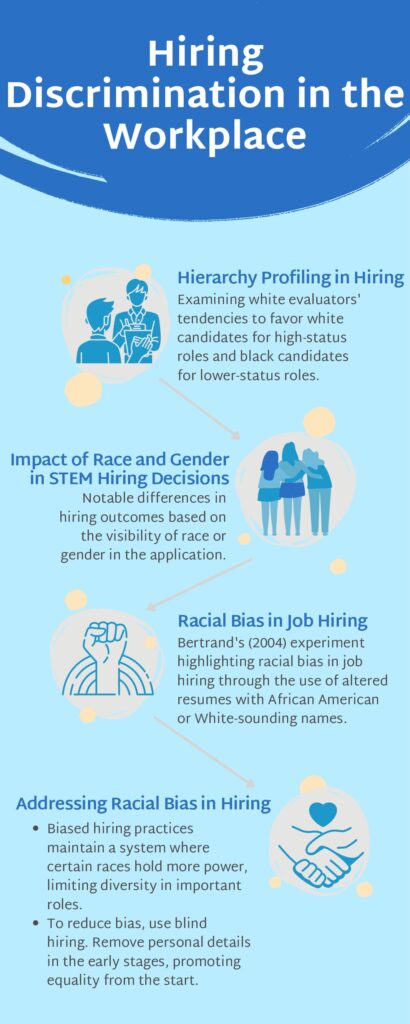By Jonas Wachman Goncalves and Ryan Carey
Summary
Discrimination in the hiring process has been a concerning issue, surrounding various forms such as racial, gender, age, and ethnic bias. Despite having some advancements in encouraging diversity and inclusion, many individuals continue to face unequal treatment based on their race. Racial minorities and individuals from marginalized communities often encounter barriers to equal opportunities, fair pay, and career advancement. Discrimination can manifest in biases, unequal representation in leadership roles, and even in hiring processes. Addressing workplace discrimination requires efforts from organizations to promote inclusive environments, raise awareness, and implement anti-discrimination policies.
Depiction

Evidence
Cydney’s (2021) article explores how white evaluators tend to favor white candidates for high-status roles and black candidates for lower-status roles, maintaining a hierarchical structure. The study investigates three factors influencing this bias: role status, representativeness, and hierarchy profiling. Through three experiments, white evaluators assessed the suitability of white and black candidates for different roles. Predictably, the study found that evaluators prefer white male applicants for high-status roles, while black applicants were seen as more suitable for lower-status roles.
In another article, Identical applicant but different outcomes: The impact of gender versus race salience in hiring. Group Processes & Intergroup Relations, dives into the impact that race and gender have on the hiring decisions of an Asian American woman in STEM fields. The authors, Rattan, A., Steele, J., & Ambady, N. (2019) created three different studies using student samples. In these studies, the authors makes either the race or gender of the applicant apparent when they apply to jobs that are typically worked by men. When the Asian woman’s race was made notable with her application, male evaluators were more likely to hire and offer higher pay in science and technology-related fields. However, when just gender was made apparent in the application the opposite was seen. In both articles, we see immense examples of racial bias in the hiring process.
Another instance of hiring discrimination is seen in a study done by Bertrand in (2004) where researchers conducted an experiment assessing racial bias in job hiring. They sent out fake resumes in response to job ads in Boston and Chicago, altering the names of the applicants to sound either African American or White. The findings demonstrated significant discrimination against resumes with African American names, which received 50% fewer interview callbacks than those with White-sounding names.
Consequences
There are many consequences that arise from biased hiring processes. Firstly, it continues the systemic racial hierarchy that white men have controlled since the start of slavery. If people of diverse backgrounds, race, or even gender are not given the same opportunity the system will never be broken. As well as diversity not being introduced into places of influence. Additionally, implicit bias is another concept holding back equality in the hiring process. Implicit biased does and can lead to employers making unfair and discriminatory decisions. It also brings up the issue of hiring someone white who is less qualified than someone of a different race.
Policy Intervetntion
By promoting diversity, equity, and inclusion, workplaces can become more supportive and respectful of the diversification of human experiences. Ongoing education and systemic changes are crucial to creating workplaces that truly embody the principles of equality and fairness for all races. A policy recommendation that would help create an inclusive workforce would be to create a blind hiring process. Suggesting that to minimize bias, employers should remove names, race, gender, and other identifying information from resumes in the initial screening process. By creating a blind hiring process there would be limited bias in the hiring process. The hiring of someone would come down to what they have accomplished on their resume.
Questions
- Why after so many years of trying to end racial bias do we see that top corporate positions are predominantly run by white men?
- How can we create policies and changes that will help break this cycle of underrepresentation?
Sources
Rattan, A., Steele, J., & Ambady, N. (2019). Identical applicant but different outcomes: The impact of gender versus race salience in hiring. Group Processes & Intergroup Relations, 22(1), 80-97.
Cydney H. Dupree, Brittany Torrez (2021). Hierarchy profiling: How and why a job’s perceived impact on inequality affects racial hiring evaluations, Journal of Experimental Social Psychology, Volume 96.
Bertrand, M., & Mullainathan, S. (2004). Are Emily and Greg more employable than Lakisha and Jamal? A field experiment on labor market discrimination. American Economic Review, 94(4), 991-1013.





